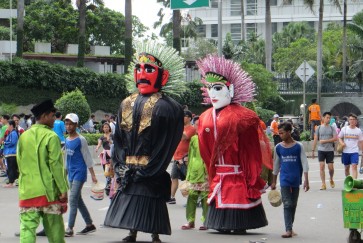Perennial Sumatran favorite: `empek-empek'
Variations on a theme: There are so many different kinds of pempek (photo above) that there is bound to be something to suit most tastes
Change text size
Gift Premium Articles
to Anyone

Variations on a theme: There are so many different kinds of pempek (photo above) that there is bound to be something to suit most tastes. For South Sumatrans, eating pempek is almost obligatory – the day just doesn’t seem right until the first one is eaten. JP/Khairul Saleh
For many, the pempek or empek-empek - a fish dumpling long known as a special delicacy from Palembang in South Sumatra - needs little introduction.
For South Sumatran natives, pempek is, well, obligatory - they'll eat it at any time, including in the morning. Indeed, many people find they just don't feel right until they have their first pempek of the day, even though munching on it in the morning is a common cause of a colicky belly. But everyone does and can, since its price makes it accessible for all levels of society.
But the dumpling is not enough on its own. It certainly lacks its full effect unless it is served and eaten accompanied by a blackish-brown sauce called cuka or cuko in the Palembang language.
This is a vinegar made from boiling water, brown sugar, crushed chili, garlic and salt. The spicy flavor spurs the appetite, but there is also a sweet vinegar for those who don't like hot chili.
There are many types of pempek, each with its own distinctive flavor. There are boiled, fried and grilled pempek. There's the pempek that includes tofu, and pempek telur, which includes egg yolks, pempek kapal selam, or submarine pempek, also made with eggs, and pempek keriting, which is shaped like a ball. Pempek panggang is pempek made with hot dried shrimps, or shrimp ingredients, and grilled straight away.
There are plenty of variations on the theme also. An extension of pempek is the otak-otak. These are pempek that have been wrapped in banana leaves and then grilled. Pempek lenggang consists of chopped-up pempek mixed with duck eggs, which is then fried or grilled with banana leaves.
Pempek lenjer, pempek bulat (called ada'an), pempek kulit ikan (fish skin) and pempek pistel are all made with boiled young papaya shoots, which are included in the ingredients, and pempek telur kecil (small eggs).
Simply sample them all until you find the one that best suits your taste.
Historical records and oral legend have it that pempek has been in Palembang since the arrival of the Chinese, which was around 1617 when Sultan Mahmud Badaruddin II reigned in the Palembang-Darussalam sultanate. The name empek-empek or pempek is believed to have derived from the word apek - the word used in the Palembang community for old men of Chinese descent.
Perhaps. Saudi Berlian, a 46-year-old Palembang sociologist, tells the story of an old man of Chinese ethnic descent who wanted to turn an excess of fish from the Musi River into a useful product. The local community used the fish in a limited way only and just to satisfy daily needs, and the fish were only fried or preserved.
"He *the oldman* then tried to process the food by mixing minced fish with tapioca flour," Saudi said. "So in this way it became a new food, which later on became known by the name of pempek. This was sold by street vendors around the city who went to and fro in the kampungs."
Initially, pempek was made from Belinda fish, which are now protected and the symbol of South Sumatran fauna. The recipe was then changed to use various types of freshwater fish such as gabus (Channa striata), ikan putak, toman and bujuk. At this time saltwater fish such as mackerel and red sea perch were often used. All of these taste delicious and make good eating.
It is quite possible that those outside the South Sumatran community will be surprised to learn the vast range of dishes can be produced from just this one item, pempek.
These include the well-known dish laksa, which is served with coconut cream broth. Then there are model and tekwan, which are served in a clear broth to which has been added special spices, and mixed kuping gajah (elephant ears) and shrimp heads.
The results of an analysis by the Palembang Health Polytechnic Nutrient Department show that the composition of the nutrients in pempek differs according to the types of fish and the raw materials used.
But pempek's nutritional value is certainly quite high, because the food contains carbohydrates, proteins, vitamins, minerals and fats, thanks to its main ingredients of fish, sago and eggs. Consequently, it's not surprising that this special food is loved by all classes and ages.
Among the many types of pempek, the type known as kapal selam pempek has levels of proteins, fats and vitamin A that are higher than other types, because of the amount of eggs included. The nutritional analysis shows that every 100 grams of kapal selam pempek contains 189.8 calories, along with 13.2 grams of protein, 6.6 grams of fat, 500.0 milligrams of calcium and 150.0 milligrams of iron.
The combination of fish, water, tapioca flour and salt strongly influences the nutritional value, taste, color and texture. And of course the fish is the main contributor. The more fish that is used, the greater the levels of fat, protein and flavor - although the price also rises. Pempek that is sold cheaply is usually made from cornstarch with added monosodium glutamate (MSG).









